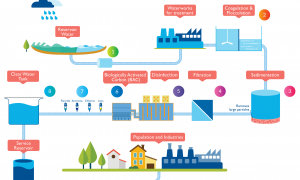🕑 Reading time: 1 minute
Filtration is a process in which water is passed through the beds of fine granular materials like sand. The bed of fine granular materials is known as a filter and it helps in removing impurities to a great extent. The purpose of filtration after screening and sedimentation is to attain palatable and potable water in the end. It helps to remove bacteria, odor, color, and turbidity from water.
Rapid sand gravity filters and slow sand filters are two types of filters that are commonly used for treating water. The slow sand gravity filter (or slow sand filters) removes a larger percentage of bacteria and impurities but has a very slow rate of filtration and is expensive. On the other hand, rapid sand gravity filters (or rapid gravity filters) are universally adopted as they help to disinfect and remove the color from the water that is fed directly from the sedimentation plant.
Differences between Rapid Gravity Filters and Slow Sand Filters
| Sl. No. | Particular | Rapid Gravity Filters | Slow Sand Filters |
| 1 | Pre-treatment requirement | The water must undergo coagulation, flocculation, and sedimentation. | Raw water either without any treatment or having undergone sedimentation can be fed. |
| 2 | Base material | The sand is supported by the gravel base. The base also distributes the water uniformly on the sandy surface. It ranges from 0.6 to 0.9 m in depth and 3 to 40 mm in size. | The sand is supported by the gravel base. It ranges from 0.3 to 0.75 m in depth and 3 to 65 mm in size. |
| 3 | Filter sand | The effective size varies from 0.35 mm to 0.55 mm and the uniformity coefficient is between 1.2 to 1.8. | The effective size varies from 0.2 mm to 0.4 mm and the uniformity coefficient is between 1.8 to 3. |
| 4 | Size of each unit | The area occupied is small and is about 10 to 80 sq.m (5 m x 8 m). | The area occupied is huge and is about 100 to 2000 sq.m (30 m x 60 m). |
| 5 | Ease in construction | Complicated to construct. | Simple to construct. |
| 6 | Rate of filtration | Large capacity i.e. 3000 to 6000 lit/hr per sq.m of filter area. | Small capacity i.e. 100 to 200 lit/hr per sq.m of filter area. |
| 7 | Loss of head | Initial loss is 0.3 m, and approximately 2.5 to 3.5 m when cleaning is required. | Initial loss is 0.1 m, and approximately 0.8 to 1.2 m when cleaning is required. |
| 8 | Flexibility | The filter can sustain reasonable variations and thus is very flexible. | Cannot meet demand variations and thus not flexible. |
| 9 | Efficiency | This filter is well known for handling turbid water. Although it removes only 80% to 90% of bacteria, it efficiently removes color and turbidity. | This filter removes bacteria effectively up to 98% to 99% but not very effective when it comes to eliminating color and turbidity. |
| 10 | Under-drainage system | The under-drainage system is laid not only to receive filtered water but also to pass water for carrying out backwashing. | The under-drainage system is laid to receive filtered water. |
| 11 | Post-treatment required | It is a must to carry out disinfection. In addition to this, other miscellaneous treatments can be carried out if needed. | The water obtained is very pure but disinfection can still be carried out. Any other treatment is not required. |
| 12 | Economy | It is economical and cheap as the initial cost is low. Operation and maintenance (O&M) costs are high. | The initial cost of the land and material is high but O&M costs are low |
| 13 | Depreciation cost | High depreciation cost. | Low depreciation cost. |
| 14 | Requirement of skilled supervision | Skilled supervision is essential. | No need for skilled supervision. |
| 15 | Cleaning | Frequent cleaning has to be done within a span of 1 to 3 days. 1% to 5% of water filtered is required for cleaning. Cleaning is comparatively easier as sand grains have to be agitated and backwashing can be done with/without compressed air. | Cleaning has to be done within a span of 1 to 3 months. 0.2% to 0.6% of water filtered is required for cleaning. Cleaning is comparatively laborious as 1.5 to 3 cm thick layer has to be scraped and removed and washed down by hoses. |


FAQs
Filtration is a process in which water is passed through the beds of fine granular materials like sand it helps in removing impurities to a greater extent.
Rapid gravity filters, slow sand filters, and pressure filters are the types of filters.
Read More
Different Types of Sedimentation Tanks used in Water Treatment


